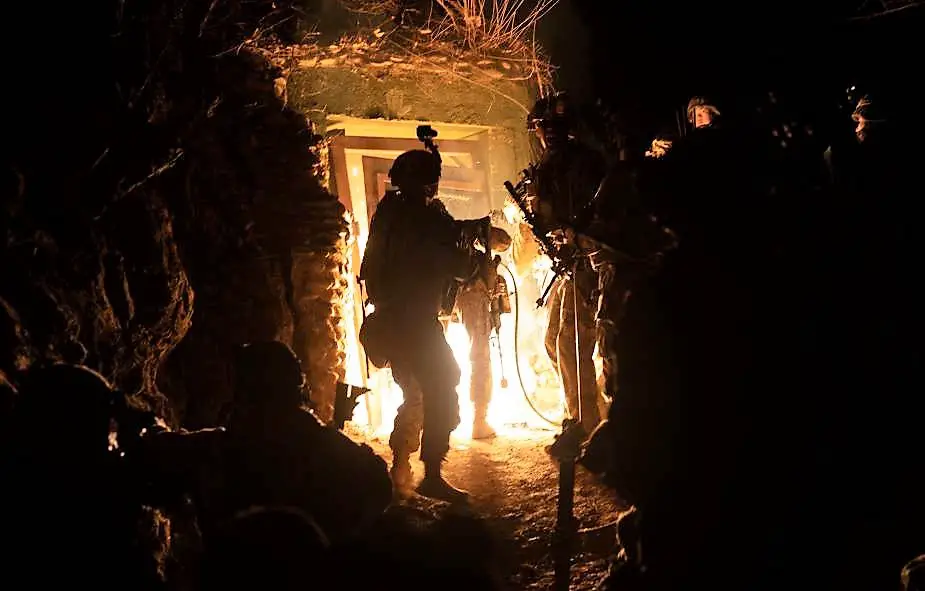Breaking news
US Army trains in South Korea for underground operations.
Beneath the streets of the densely-populated Korean peninsula, U.S. Soldiers donned in heavy gear, traverse South Korea’s dim, underground tunnels. To better face the daunting challenge of combat in large cities, soldiers of the 2nd Infantry Division, 8th Army, have taken a step further: learning to move underground in the East Asian nation. Joe Lacdan, Army News Service, reports.
Follow Army Recognition on Google News at this link

U.S. soldiers with 2nd Bde, 2nd Infantry Div, breach the entrance of an underground complex during the early morning on March 16, 2023, at Goldmine Training Area, Republic of Korea, during Exercise Warrior Shield (Picture source: U.S. Army/Sgt. Joshua DuRant)
8th Army commander Lt. Gen. Bill Burleson said that soldiers will need to learn how to operate below the surface to avoid sensors and monitoring devices on the ground level: “When you look at the ability to move underground, in some ways the tunnels are completely unseen by other sensors,” Burleson said during the annual Land Forces Pacific Symposium May 17. “We've got to be able to do that and fight in terrain. And in cities, some of that involves tactics and techniques. There's a leader development aspect to that. There's a [communications] aspect to that.”
Four known underground tunnels exist in the 150-mile demilitarized zone between North and South Korea in the peninsula’s center. U.S. Soldiers from the 2nd ID and the Republic of Korea have built subterranean training facilities to prepare for conflict in cities. The partner nations engaged in exercise Warrior Shield in March 2023 to strengthen US and ROK collaboration across all domains while improving tactics and procedures. The combined forces also conducted air assault and ground forces operations.
During Warrior Shield, soldiers from the 2nd Brigade, 2nd Infantry Division simulated breaching the entrances of underground buildings. “They have actually acquired some material solutions to operate underground better without constraints,” Burleson said. “That will allow them to operate in underground facilities … and we know there are facilities under North Korea that we've got to be prepared for should conflict come.”
The headquarters of the 8th Army at Camp Humphreys, South Korea sits 40 miles outside of Seoul, a city of 10 million, where the most efficient form of travel lies underground in the city’s subway systems. To prepare for possible conflict, Burleson said Soldiers must become proficient in subterranean operations through training. “Without degradation, they'd be able to evacuate casualties [and] be able to see, sense and communicate effectively,” he said.
Army Training and Doctrine Command adopted urban warfare training into its training centers, as the Army shifts from anti-insurgency operations to large-scale ground combat. “Increased urbanization is unavoidable,” Burleson said. “Conflict in urban areas is unavoidable. Although warfare has evolved, we’ve just got to accept the fact that there’s more to be done if we want to be prepared.”
Burleson said the shift to urban combat has become more apparent during the Ukraine-Russian conflict where the enemy combatants have fought in city settings. He added that the Army and U.S. forces must develop capabilities across multiple domains including communications functioning effectively in a cyber and electronic space.
Burleson added that in cities, U.S. Soldiers will have to learn to operate in tight spaces and battle with precision weapons while considering the danger of using weapons near a civilian population. Retired Army Maj. Gen. Laura Yeager, former commander of the National Guard’s 40th Infantry Division, added that U.S. forces must adapt to the unique conditions of combat in large cities. “You might have to use fires but you’re going to want to understand what those weapons’ systems’ effects are on the urban environment,” she said. “They may not have the effect that you expect.”
She said that in urban environments, aircraft such as helicopters will be more vulnerable to small arms fire as well as have limited places to land. She added that military leaders must make other considerations, such as enlisting the help of law enforcement and civic agencies.
Burleson said that the commitment to planning for combat in urban zones requires collaboration and interoperability achieved through exercises like Warrior Shield. If forces do not prepare themselves, U.S. Soldiers and their allies may risk repeating history such as during the Battle of Osan on July 5, 1950. A North Korean Army had already captured Seoul from the South Korean military. Poorly-equipped and unprepared U.S. forces suffered heavy casualties during the fight. “We've got to have a willing commitment to prepare and be ready,” Burleson said. “Otherwise, we're going find ourselves where we were on the fifth of July, 1950. We must be ready.”
Defense News June 2023























